What we do
Services
Experts in
Once upon a time, some ambitious startup founders were set on building instant messaging software. They were absolutely sure their product would succeed — the market was full of opportunities!
They worked hard, spending sleepless nights writing code, creating interfaces, fixing bugs, and polishing the application they believed in so much.
In six months, their worries escalated alongside their anxiety and fatigue. They argued and tried to improve the product, add new features, and make it as good as possible to ensure their good reputation and their customers’ satisfaction.
But when the launch day came, nothing happened.
Despite all the effort, lines of code, sleepless nights, and dead nerve cells, users didn’t even download the product.
Is this a real story? Yes, it is.
Was the product worth the effort? Yes, it was.
Did the co-founders benefit from this experience? Yes, they did.
This is the story of how Eric Ries, a serial entrepreneur, blogger, startup founder, and the author of The Lean Startup, launched IMVU. Though Ries didn’t appreciate this experience at the time, it help him launch his own successful software product development solutions and enabled him to help other startup founders create their own successful businesses.
Inspired by Eric’s success and driven by our own experience with startups and developing minimum viable products, we’ve created this article to show you how to build an MVP the right way — a way that will help you test your idea, attract your first customers, and raise enough funds to build a successful and mature product.
This article will save you time on studying tons of materials and searching for success stories and best tips to create an MVP; here, you can find it all.
Here’s a fact: 90% of tech startups fail. Is your goal to land among the remaining 10%? Focusing on process preparation and planning is your key to success.
Creating an MVP is a way to start testing an assumption, and working on turning your idea into a viable product.
The entire journey of a startup founder consists of three major steps that form a never-ending circle:
Then the startup founder learns again to find gaps, assess risks, and satisfy users’ demands more completely to then build a better product and measure improvement so they can use these insights in the next iteration.
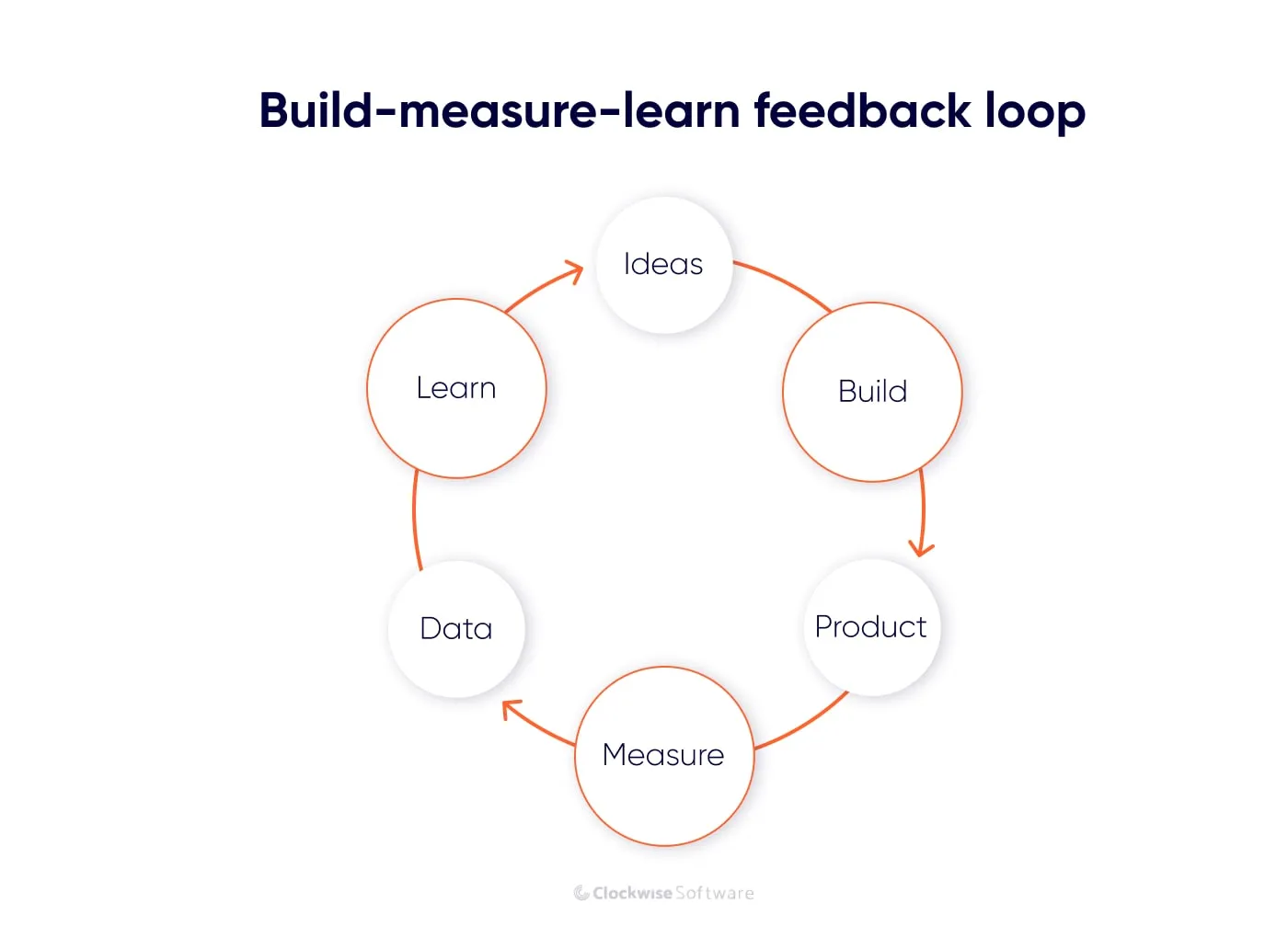
Some experts call this circle the Build-Measure-Learn loop or the lean strategy; others say it is an Agile process, and the TripAdvisor founders call it the Speed Wins mantra.
No matter what you call it, the core of the process is the same: startup founders go through this loop to achieve their goals.
What’s the role of an MVP methodology in this loop?
According to Eric Ries, “the MVP is that version of the product that enables a full turn of the Build-Measure-Learn loop with a minimum amount of effort and the least amount of development time.”
There are various reasons for building an MVP app: validating an idea, generating initial income, attracting investors. But in general, there is a single idea behind all these reasons: testing assumptions.
But no matter how deep your background knowledge is or how many years of experience you have, you can’t be sure about any of these assumptions before you test and validate them.
That’s when a minimum viable product comes into play.
You can build an MVP with minimum time and at minimum cost if you only prepare properly and follow tried and tested practices for successful MVP development.
Deciding to build an MVP is a good idea — you have to start small now to become big later.
Let’s assume you already have an idea and a plan of action. You’ve set your basic goals and even have an awareness of the target market. Taking the shortest possible path to get your application to the market is your number one priority.
At this point, you’re probably drowning in jobs to be done. So try to minimize unnecessary tasks and focus on the following steps to reach your goals:
Your idea may seem ingenious, and you may want to immediately start development.
But should you really dive into coding and product development right now?
Unfortunately, there is always a danger of recognizing that an idea is great but no one actually needs it.
Fortunately, you don’t need to invest in an MVP development process to find out that no one needs your product.
Your first step should be defining an existing problem your app will solve. Solutions for real-life problems are more likely to find users than solutions for problems users didn’t know they had.
One of the safest ways to build an MVP is to target problems within industries you’re familiar with.
Are you a former writer who knows about publishing challenges in your country? Generate a solution for the local publishing industry.
Are you a chef who wants to launch an app with top vegan recipes? That’s great, since you know about the app’s content from the inside out.
Or are you a former teacher who wants to launch an app for a local educational institution, or a business owner who runs an offline business and needs digital support?
Analyze the industry you would like your app to operate in, identify real users’ pain points, and decide how to fix them.
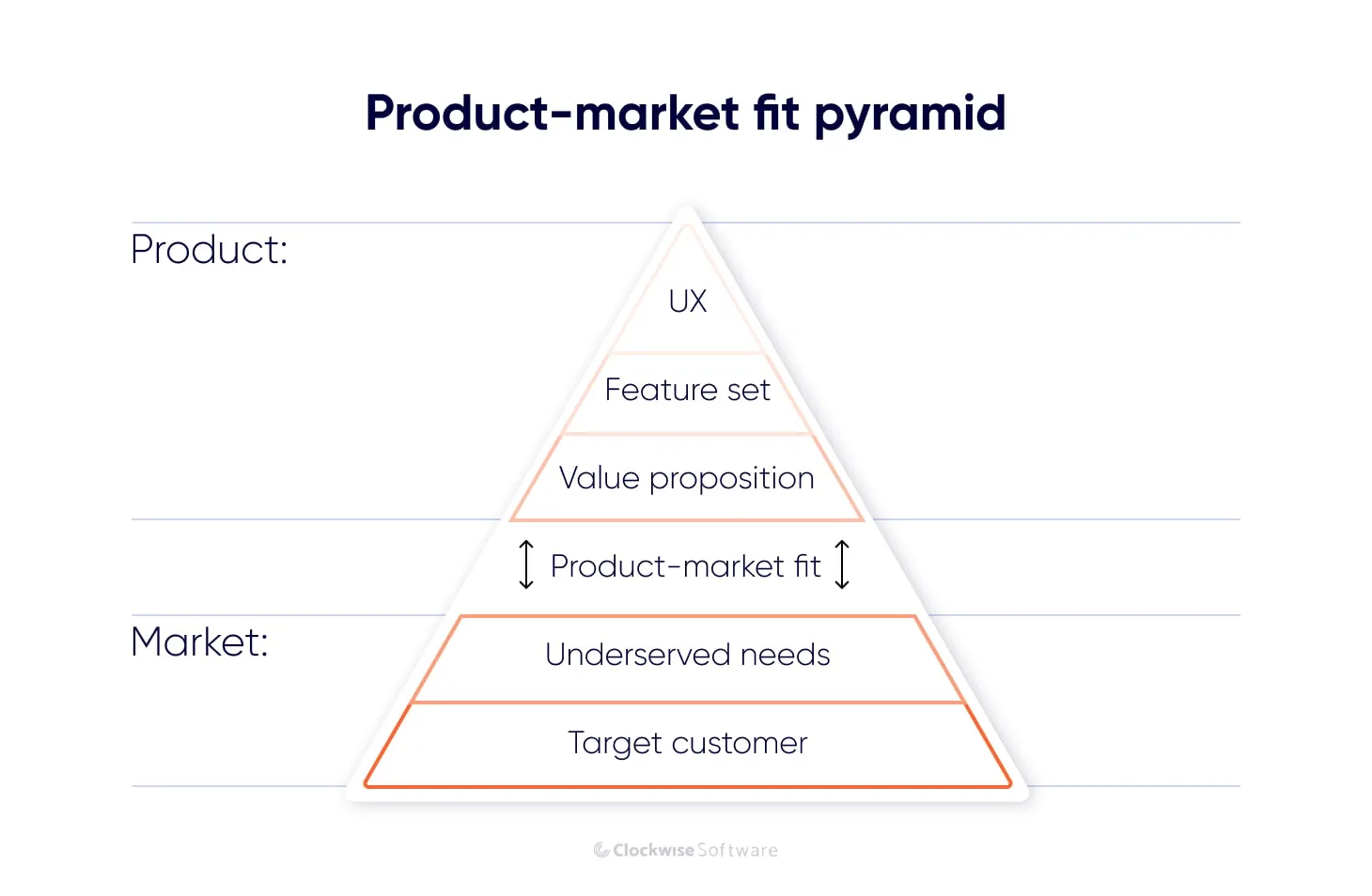
Defining unmet needs will help to bridge your product with your target market and find product–market fit.
Most products and companies operate in the red ocean of opportunities. This means they create solutions that are similar to rivals’ and try to outrun competitors in terms of quality, price, or user satisfaction.
Startups have a chance to act differently and either identify or create a blue ocean of opportunities.
Blue oceans are defined by untapped market space, demand creation, and the opportunity for highly profitable growth.
This graph describes the performance benefits of creating blue oceans:
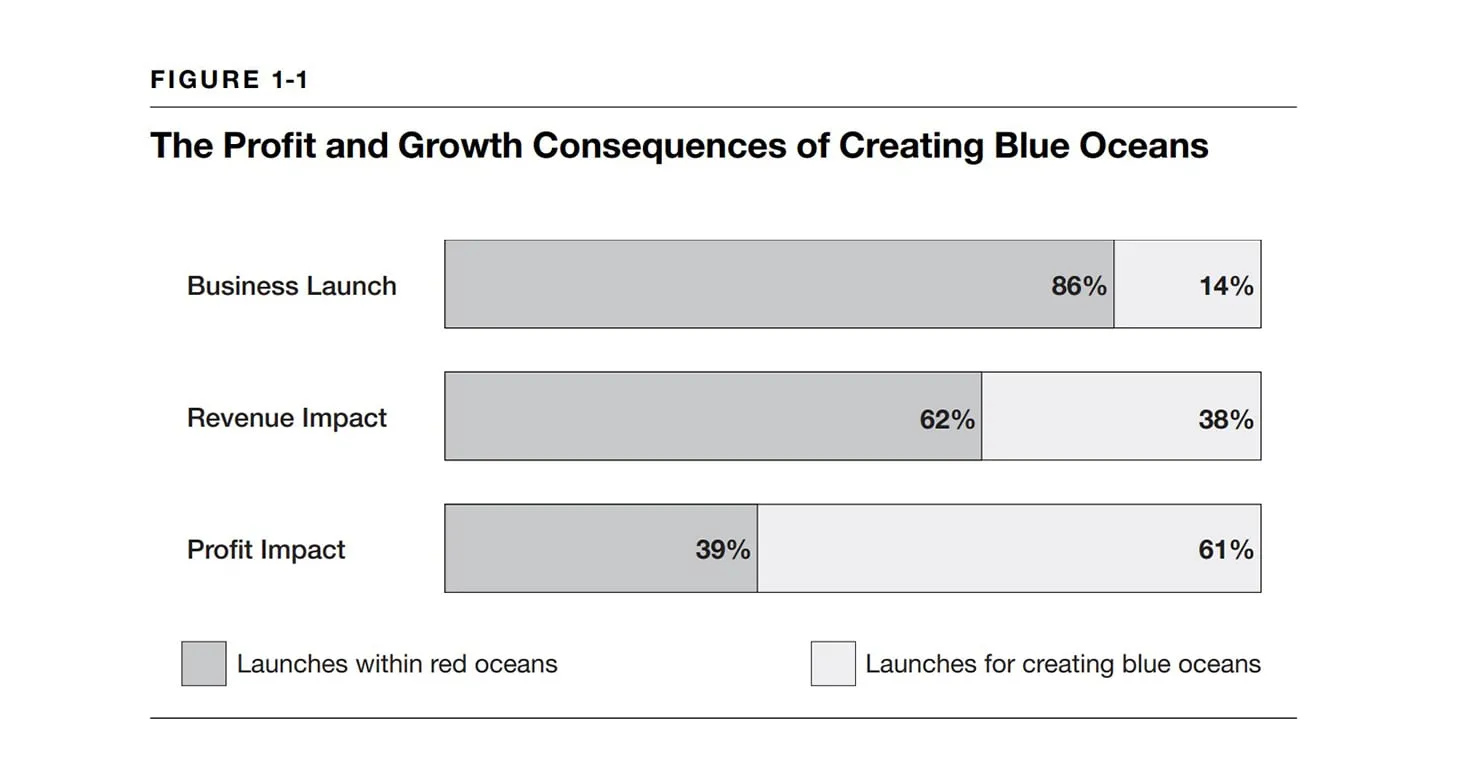
According to the book Blue Ocean Strategy by Renée Mauborgne and W. Chan Kim, back in 2004, 86% of launched businesses accounted for 62% of total revenue but only 39% of total profits. Meanwhile, a small number of companies operating in the blue ocean were responsible for the major part of total profits.
Blue oceans create favorable conditions for companies to grow, profit, and succeed.
Finding or creating a blue ocean and solving users’ needs in a unique way can accelerate your product’s growth.
Have you watched or listened to the legendary TED Talk by Simon Synek?
People don’t buy what you do, they buy why you do it.
Before you get busy with MVP development, think about why you want to do it.
Simon pays particular attention to these three questions:
Another crucial question we’d recommend answering is why should your product or your company exist?
By answering these questions, you can better understand your plans and objectives, focus narrowly on your goals, and more clearly see problems you can solve with your app.
35% of startups fail simply because nobody needs them; so if you can clearly see _why _you should launch your startup and _who _would like to use your product, you may avoid failure.
Your first steps define the whole business path.
Give as much time and pay as much attention as you can to initial decisions, focus on a particular problem that bothers potential users, and brainstorm ways to address it with a minimum viable product.
At this stage, MVP documentation such as a business model canvas and an MVP roadmap may help you focus on concrete needs and help you with planning the next steps.
Now, let’s talk about who.
The co-founders of Botnim — a web application to find nutritional information about foods in the nearby restaurants — shared a million dollars’ worth of insights in their startup’s post mortem.
“Market validation is definitely one of the first things I’d do. Specifically, in Botnim’s case, I would have checked with people what they want before assuming it, then execute accordingly,” says Shaked Klein Orbach in an interview for Failory.
The Botnim founders launched an app without paying enough attention to their audience. They targeted users who eat outside, but it turns out that not enough people who eat outside care enough to download an app that tells them about the amount of fat, carbs, and proteins in their food.
Before starting to build an MVP, check what people want and define your target audience.
No doubt you want your solution to serve as many people as possible.
But trying to target all users everywhere makes you unfocused. Getting everyone to use your application is impossible. It’s much easier to satisfy a specific group of people.
Build your user persona and make it specific. Provide as many details as you can, such as a potential buyer’s age, profession, education level, income, family, hobbies, fears, and goals. The better you understand your potential customer, the better you can tailor your product to meet their expectations.
Are you planning to create a blue ocean of opportunities and develop an innovative product for your target audience? With such an ambitious goal, you may want to get acquainted with the theory of diffusion of innovations.
This theory describes five key elements that impact how innovative ideas, technologies, and products spread:
To more precisely define your target audience, get acquainted with groups of adopters:

In his TED Talk, Simon Sinek pays particular attention to early adopters, as these are the users able to spread the word about your product and help you reach the mass market. Try to define** who **your product’s early adopters are and make the diffusion of innovations work for your business.
In MVP development, less is more.
A narrow focus is a winning strategy. Having a small group of target users is better than trying to attract everyone. A single wisely chosen feature is better than a half-boiled feature soup.
Focus on only one essential feature during the initial stages of product development.
Let’s look at an example.
Say you’re planning to build a car, and your assumption is that potential customers want to get places faster. You are about to invent a car. But building a car will cost you a lot of time and money. And before investing in your idea, you decide to test your assumption by building a minimum viable product.
You offer a skateboard — a primitive device that solves the identified problem and helps people move faster. If your target audience is interested in the skateboard, then your were right. Potential customers are in need of a vehicle, and they are ready to pay for it. So you can move on and add some other features until you are ready to build a car.
As Marty Cagan says, “it’s all about solving problems, not implementing features.”_ _Offering tires won’t solve the initial problem. But offering a skateboard will.
The product you release first might be primitive. However, if your idea provides an effective solution to an existing problem without neglecting user experience, it will attract users, and the MVP will fulfill its mission and prove the assumption.
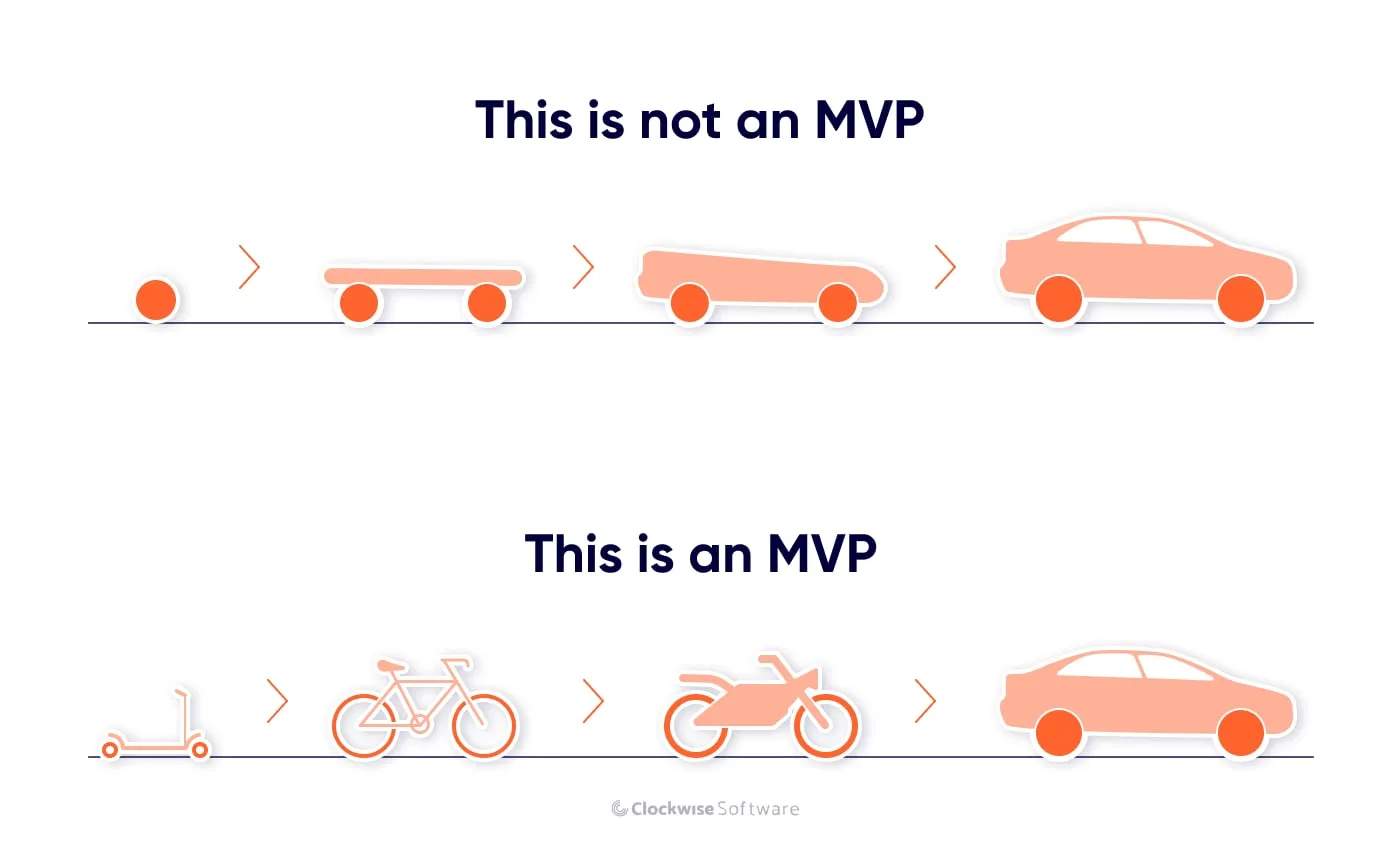
The Pareto principle may come in handy when deciding on your product’s core feature.
Roughly 80% of consequences come from 20% of causes.
Let’s apply this principle to your app: 80% of your customers will use 20% of the functionality your app offers. So there’s no need to spend months packing your MVP with features users probably will never notice. Invest your resources in that critical 20% of functionality. Create the long list of features you would like to add to your app, then determine the crucial 20% that will cover 80% of users’ needs.
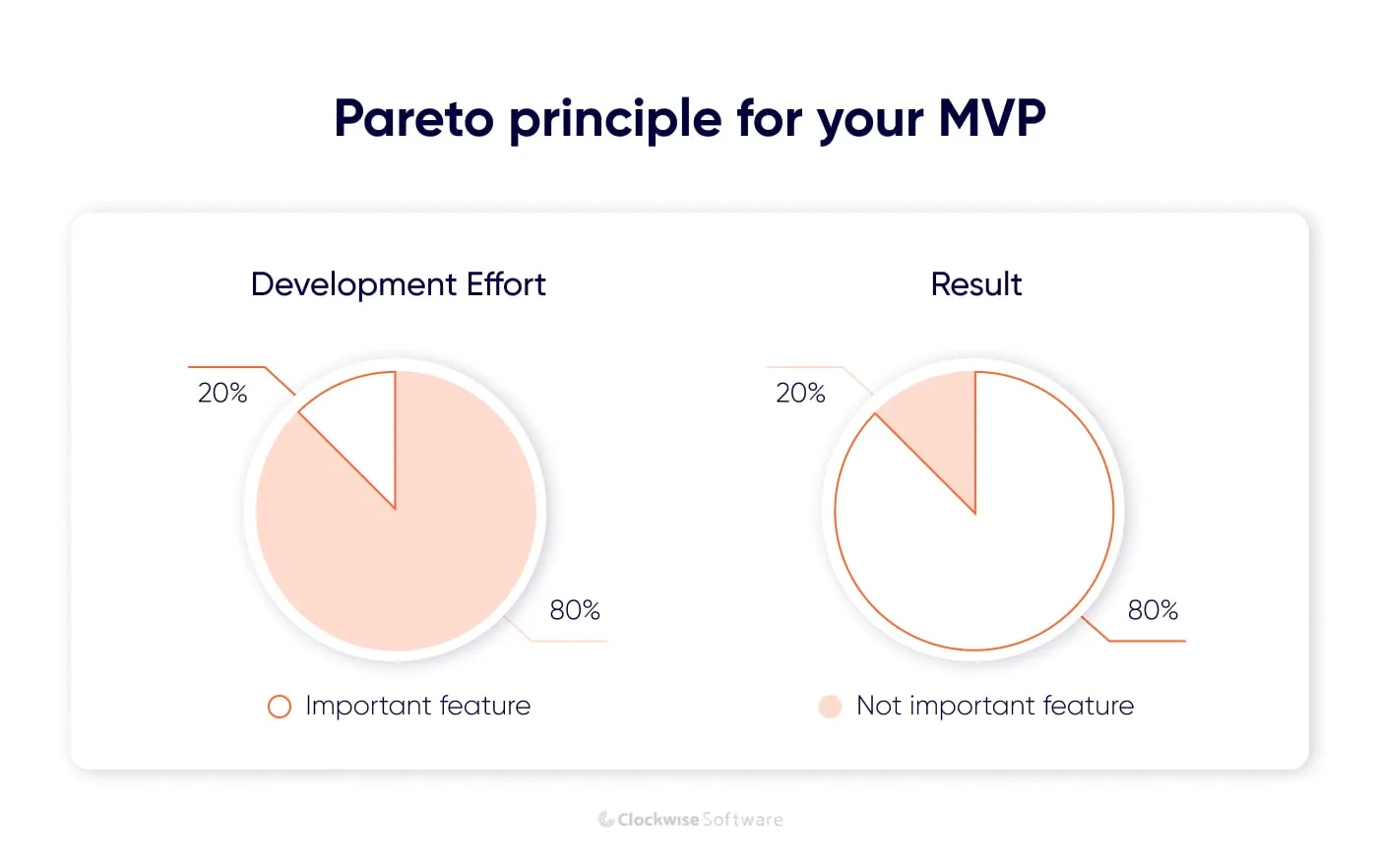
The best strategy is starting with the minimum set of core features that will bring value to your customers.
The goal of the minimum viable product is to minimize your time through the Build-Measure-Learn loop.
So at this stage, forget about perfection. The only aim is releasing the application in the shortest time possible in order to test assumptions without a lot of risk.
The sooner real users can start using the product, the better. Their feedback will show whether there’s an interest in the kind of app you want to develop or whether developing it would be a complete waste of time and money.
What options can you consider to build an MVP?
These two options are more like a pre-MVP that allows you to check the business viability of your idea.
A concierge MVP is a product that outlines your main idea. You personally bring this MVP to customers and ask if they want to try it.
For example, say your goal is to build a grocery app that helps chefs get high-quality products from local manufacturers. Before you have actual software and before anyone is interested in your offer, you can collect a list of local manufacturers, put it into a spreadsheet, and bring it to chefs. The chefs’ reactions, interest, or disinterest will help you understand if there’s demand for your app.
A fake door MVP is closer to the real solution than a concierge MVP. Let’s consider a grocery app. Instead of creating spreadsheets, in a fake door MVP you pretend to provide a real product and ask customers to take a desired action. So you create a simple landing page with a catchy title describing the app’s key goal and ask customers to act on it. For example, you can create a CTA button with the text Click here and get the best groceries in the city! If potential users click the button, you can assume there’s demand for your app.
If you create a fake door MVP, we recommend you explain to users who complete the target action what you’re doing and why you’ve asked them to click a button without having functionality to address their needs. Take a look at how Buffer dealt with this.
Buffer is a marketing and social media platform with more than 73,000 subscribers. In 2010, the founders launched a simple two-page MVP with an explanation of how Buffer can help businesses. Joel Gascoigne, a Buffer co-founder, then shared the link to the MVP on social media and collected initial feedback. After clicking on the CTA, users were redirected to a web page explaining that Buffer was still working on the advertised features and that the team would notify interested users once everything was ready.
This was the simplest way to test the idea, and the test showed that the idea had to go live!
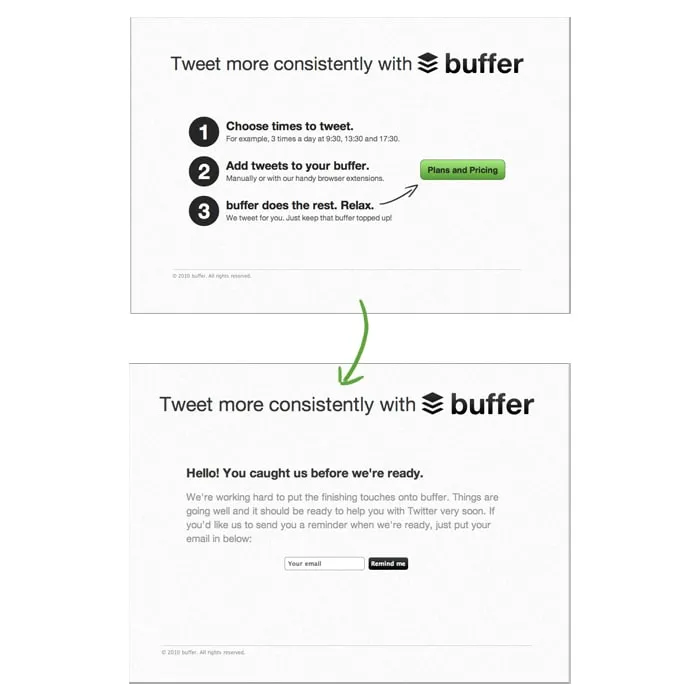
A concierge MVP and fake door MVP are experiments — simple ways to check if your target audience is interested in your app.
This is why even if you start with this sort of MVP, you may still need to invest your time in a “real” MVP to check technical feasibility.
No-code and low-code platforms have many advantages, and one of them is the speed of development. A low-code platform may save you up to 60% of time on MVP development. It also requires less tech and coding skills compared to custom development.
No-code and low-code solutions will help you launch your MVP faster, but they put you in the same situation as the concierge and fake door approaches. Although these development methods are fast and allow you to check business viability, they give you limited functionality and few customization opportunities. Besides, it’s nearly impossible to scale no-code solutions.
When building an MVP, you can opt for low-code solutions; however, as your product will grow and scale, you will still need to go with custom development.
A custom MVP is an app your development team builds from scratch. Before development starts, engineers suggest the optimal technology stack, app architecture, logic, and interface design. Once you approve these critical things, the team starts coding.
Typically, it may take up to 1000 development hours to build an MVP. During this entire time, a project manager and business analyst keep you informed about the progress, possible challenges, and ways to overcome them. The development team also checks on potential competitors to suggest ways to build a better solution.
Building a custom MVP requires more time than building a concierge MVP or a low-code MVP; however, it provides you with answers to multiple product-related questions, starting with answers to the two most significant questions:
At the same time, a custom MVP lays the perfect ground for further improvements and development of a mature product.
With answers to these questions, you can be confident in your next steps and in the viability of your idea.
Once your MVP is ready, it’s time to thoroughly test it. This process consists of two major parts: quality assurance (QA), when the team of engineers checks functionality, and user testing, when users try your app.
The MVP testing stage starts as soon as there are pieces of functionality ready for QA. Test engineers check if functionality meets the project requirements and identify possible issues. As the product owner, you should try out your app too to make sure it complies with your own vision.
Once the engineering team confirms that the MVP has no critical errors and you sign off, it’s time to put the app into users’ hands.
Remember one of the first steps we’ve mentioned, target audience definition? Find people who match your buyer persona and ask them to test this MVP.
If you have gone through all the essential stages (defining the problem, target audience, and minimum features set) you’ll receive relevant feedback. This will be your clear guide as for what to do next.
Customer feedback is a bottomless source of information, as it:
You should collect two types of user feedback: qualitative and quantitative. To collect qualitative feedback, ask users what they like and what they don’t like about your product, what features they want to see, and what they think of the UI and app design. Quantitative feedback is all about numbers:
Use our guide on significant startup metrics to decide what you should measure and how to measure it correctly.
You may be afraid of receiving negative comments about your product. However, in the startup world, negative feedback is better than no feedback. Negative feedback is a way to better understand real users’ needs and identify ways to address them. So analyze users’ opinions and understand what you did right and what you missed.
MVPs sometimes are perceived as low quality by customers. If so, we should use this as an opportunity to learn what attributes customers care about. — Eric Ries, The Lean Startup
After you go through Build and Measure, it’s time to proceed with the Learn phase.
You started with nothing but an idea and goal.
Now you have a vision, information about real-life problems, the portrait of a perfect customer, a list of core features, a working MVP, and real user feedback on that MVP.
Instead of juggling assumptions, you can now arrange validated facts and use them to grow your business.
One of the best ways to launch an innovative product is to learn from your own mistakes and wins as well as to watch other founders’ actions.
Due to their constantly changing nature, MVPs are often considered not products but processes.
A minimum viable product is about building a product incrementally, taking as small of steps as possible and only taking one step at a time. At step one, you define an existing problem and create one assumption on how to address it.
Do small experiments, measure their impact, and learn from the results to turn your MVP into a mature product. Then, constantly improve your product to make existing customers loyal and attract new customers.
Software development is a never-ending process, and iterations are its irreplaceable components. Further work on MVP development is like running in circles. You build a product, run A/B tests for new features, get feedback, analyze it and build again to get new feedback.
Are there any other things you should know about when starting to work on your MVP?
Actually, yes, there are plenty. Here, you can find out about the top four speed bumps on your road to success and learn how to go around them.
Different countries have different rules regarding digital products. If you plan to integrate with payment gateways, you may face multiple risks, and the later you find out about them, the more it may cost you.
How to avoid it? Hire legal counsel or book a consultation with a skilled lawyer. In case you plan to use any third-party solution in your MVP, read its policies carefully and contact the support team in case something isn’t clear.
In the twenty-first century, it may seem like everything has already been discovered, invented, and built and that Elon Musk is the only person able to generate innovative cross-galaxy ideas.
Every product and every startup already has competitors, both weak and strong. However, you should not be afraid of competition but rather should consider it another source to learn from.
How to avoid it? Even if someone has launched a similar product faster than you, you still have all the chances to win market share and investors’ attention.[‘
Keep an eye on your competitors and their weaknesses. Operating in a dynamic and unstable market, make sure you react to changes swiftly. As Eric Ries says, “the only way to win is to learn faster than anyone else.”
This is one of the most dangerous potholes that may appear on your road. Having the wrong software development team means making the wrong decisions, choosing the wrong tech stack, applying the wrong processes, and creating a failed MVP.
How to avoid it? If you want to create an MVP, choose your partners and teammates carefully. Pay attention to experience and hard skills, but don’t underestimate the importance of communication, dedication, and soft skills.
Also, check if specialists you would like to work with have experience in your domain, market, or niche.
One of the best practices is to delegate engineering tasks to an entire team that has been working together and delivering projects for years. They will already know how to interact with each other and won’t need to dedicate their time to onboarding.
What if the MVP you develop doesn’t meet your expectations?
What if your developers misunderstand you?
What if they don’t see your product the way you see it?
Here’s the hard truth: they can’t see it with your eyes. They can only create their own vision based on your description and requirements.
Communication challenges and misunderstandings may lead to mismatched expectations and a delivered product that differs from the perfectly working MVP you imagined.
How to avoid it? Document everything. If you have an idea, put it down in a project brief. If you have a design vision, describe it in mockups. If you know your product’s strengths and weaknesses, explain them in a SWOT analysis.
You can create project documentation, prototypes, and your app architecture together with your development team during the project discovery phase. This is a pre-MVP stage that helps you test your assumption and validate your idea even before the actual MVP development starts. Alternatively, the results of a project discovery phase may demonstrate that your idea is impractical and help you decide to pivot in a timely manner and at minimum expense.
This is one of the most popular queries related to MVP development. But although it may seem a pretty easy and clear question, it is challenging to answer it precisely.
The price for an MVP depends on multiple factors, from the complexity of features you’d like to build to the location of your development team.
Also, the type of the MVP impacts its price, too. Concierge and fake door MVPs, as well as low-code or no-code solutions may be the cheapest for the start. The price for such products may start from $1,000 per month or even less.
But what about custom MVP price? That’s a more complex topic.
Let’s take a look at a simple comparison.
As you already know, on average, a development team needs 1000+ hours to release a simple and good-looking, error-free MVP. How much may it cost you?
You may need an internal team of 4+ specialists to launch a minimum viable product. According to Indeed, the software engineer’s average salary is around $10,000 per month. So you may need to invest at least $40,000 per month for gross pay only.
Outsourcing services may help you optimize development cost. For example, in the Eastern Europe, the price for development services fluctuates around $50-70 per hour. In 1000 hours, this team will be able to launch your MVP for as much as $50,000-70,000.
However, the precise price fully depends on your expectations and requirements, and the location of your development team.
Several years ago, Airbnb was a super simple website offering users nothing more than the ability to find an overnight stay in San Francisco.
In 2021, Airbnb’s value exceeded $113 billion.
Dropbox started by showing potential users an MVP video to see if they would be willing to try their product.
In 2020, Dropbox was worth almost $9 billion.
All great businesses were once small ideas. But testing the idea quickly, with minimum time and cost investments, has helped many businesses go above and beyond.
The best thing you can do now is to start to build, measure, and learn. Any result you collect is useful, and any step you take is right in the long-term perspective. The whole idea behind building an MVP focuses on developing an application according to the needs and preferences of real users, not just startup founders or investors. The workflow described in this article helps to ensure there will be an audience who uses, loves, and is ready to pay for your product.
Start small, learn fast, commit to iterative development, and build a perfect launchpad for your startup’s success.
